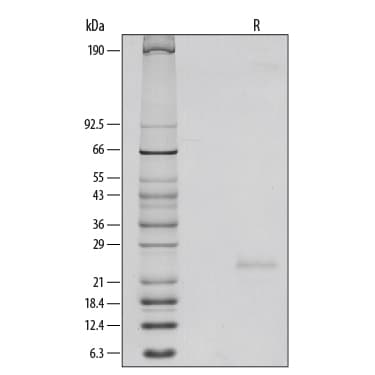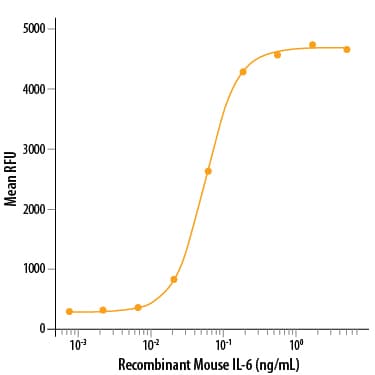 全部商品分类
全部商品分类



 下载产品说明书
下载产品说明书 下载SDS
下载SDS 用小程序,查商品更便捷
用小程序,查商品更便捷


 收藏
收藏
 对比
对比 咨询
咨询Scientific Data
 View Larger
View LargerRecombinant Mouse IL-6 (Catalog # 406‑ML) stimulates cell proliferation of the T1165.85.2.1 mouse plasmacytoma cell line. The ED50 for this effect is 10.0-100 pg/mL.
 View Larger
View Larger1 μg/lane of Recombinant Mouse IL-6 was resolved with SDS-PAGE under reducing (R) conditions and visualized by silver staining, showing a single band at 24 kDa.
Carrier Free
CF stands for Carrier Free (CF). We typically add Bovine Serum Albumin (BSA) as a carrier protein to our recombinant proteins. Adding a carrier protein enhances protein stability, increases shelf-life, and allows the recombinant protein to be stored at a more dilute concentration. The carrier free version does not contain BSA.
In general, we advise purchasing the recombinant protein with BSA for use in cell or tissue culture, or as an ELISA standard. In contrast, the carrier free protein is recommended for applications, in which the presence of BSA could interfere.
406-ML
| Formulation | Lyophilized from a 0.2 μm filtered solution in Sodium Acetate and EDTA with Trehalose and with BSA as a carrier protein. |
| Reconstitution | Reconstitute at 100 μg/mL in sterile PBS containing at least 0.1% human or bovine serum albumin. |
| Shipping | The product is shipped at ambient temperature. Upon receipt, store it immediately at the temperature recommended below. |
| Stability & Storage: | Use a manual defrost freezer and avoid repeated freeze-thaw cycles.
|
406-ML/CF
| Formulation | Supplied as a 0.2 μm filtered solution in Sodium Acetate and EDTA. |
| Shipping | The product is shipped with polar packs. Upon receipt, store it immediately at the temperature recommended below. |
| Stability & Storage: | Do not freeze.
|
Recombinant Mouse IL-6 Protein Summary
Product Specifications
Phe25-Thr211, with an N-terminal Met
Analysis

Background: IL-6
Interleukin-6 (IL-6) is a pleiotropic, alpha -helical, 22 - 28 kDa phosphorylated and variably glycosylated cytokine that plays important roles in the acute phase reaction, inflammation, hematopoiesis, bone metabolism, and cancer progression (1 - 5). Mature mouse IL-6 is 187 amino acids (aa) in length and shares 39% and 85% aa sequence identity with human and rat IL-6, respectively (6 - 8). IL-6 induces signaling through a cell surface heterodimeric receptor complex composed of a ligand binding subunit (IL-6 R alpha) and a signal transducing subunit (gp130). IL-6 binds to IL-6 R alpha, triggering IL-6 R alpha association with gp130 and gp130 dimerization (9). gp130 is also a component of the receptors for CLC, CNTF, CT-1, IL-11, IL-27, LIF, and OSM (10). Soluble forms of IL-6 R alpha are generated by both alternative splicing and proteolytic cleavage (5). In a mechanism known as trans-signaling, complexes of soluble IL-6 and IL-6 R alpha elicit responses from gp130-expressing cells that lack cell surface IL-6 R alpha (5). Trans-signaling enables a wider range of cell types to respond to IL-6, as the expression of gp130 is ubiquitous, while that of IL-6 R alpha is predominantly restricted to hepatocytes, monocytes, and resting lymphocytes (2, 5). Soluble splice forms of gp130 block trans-signaling from IL-6/IL-6 R alpha but not from other cytokines that use gp130 as a co-receptor (5, 11). IL-6, along with TNF-alpha and IL-1, drives the acute inflammatory response and the transition from acute inflammation to either acquired immunity or chronic inflammatory disease (1 - 5). When dysregulated, it contributes to chronic inflammation in obesity, insulin resistance, inflammatory bowel disease, arthritis, sepsis, and atherosclerosis (1, 2, 5). IL-6 can also function as an anti-inflammatory molecule, as in skeletal muscle where it is secreted in response to exercise (2). In addition, it enhances hematopoietic stem cell proliferation and the differentiation of Th17 cells, memory B cells, and plasma cells (1, 12).
- Mansell, A. and B.J. Jenkins (2013) Cytokine Growth Factor Rev. 24:249.
- Schuett, H. et al. (2009) Thromb. Haemost. 102:215.
- Erta, M. et al. (2012) Int. J. Biol. Sci. 8:1254.
- Garbers, C. et al. (2012) Cytokine Growth Factor Rev. 23:85.
- Mihara, M. et al. (2012) Clin. Sci. (Lond.) 122:143.
- Chiu, C.P. et al. (1988) Proc. Natl. Acad. Sci. USA 85:7099.
- Simpson, R.J. et al. (1988) Eur. J. Biochem. 176:187.
- Van Snick, J. et al. (1988) Eur. J. Immunol. 18:193.
- Murakami, M. et al. (1993) Science 260:1808.
- Muller-Newen, G. (2003) Sci. STKE 2003:PE40.
- Mitsuyama, K. et al. (2006) Clin. Exp. Immunol. 143:125.
- Cerutti, A. et al. (1998) J. Immunol. 160:2145.


参考图片
Recombinant Mouse IL-6 (Catalog # 406‑ML) stimulates cell proliferation of the T1165.85.2.1 mouse plasmacytoma cell line. The ED50 for this effect is typically 0.02‑0.06 ng/mL.
1 μg/lane of Recombinant Mouse IL-6 was resolved with SDS-PAGE under reducing (R) conditions and visualized by silver staining, showing a single band at 24 kDa.




